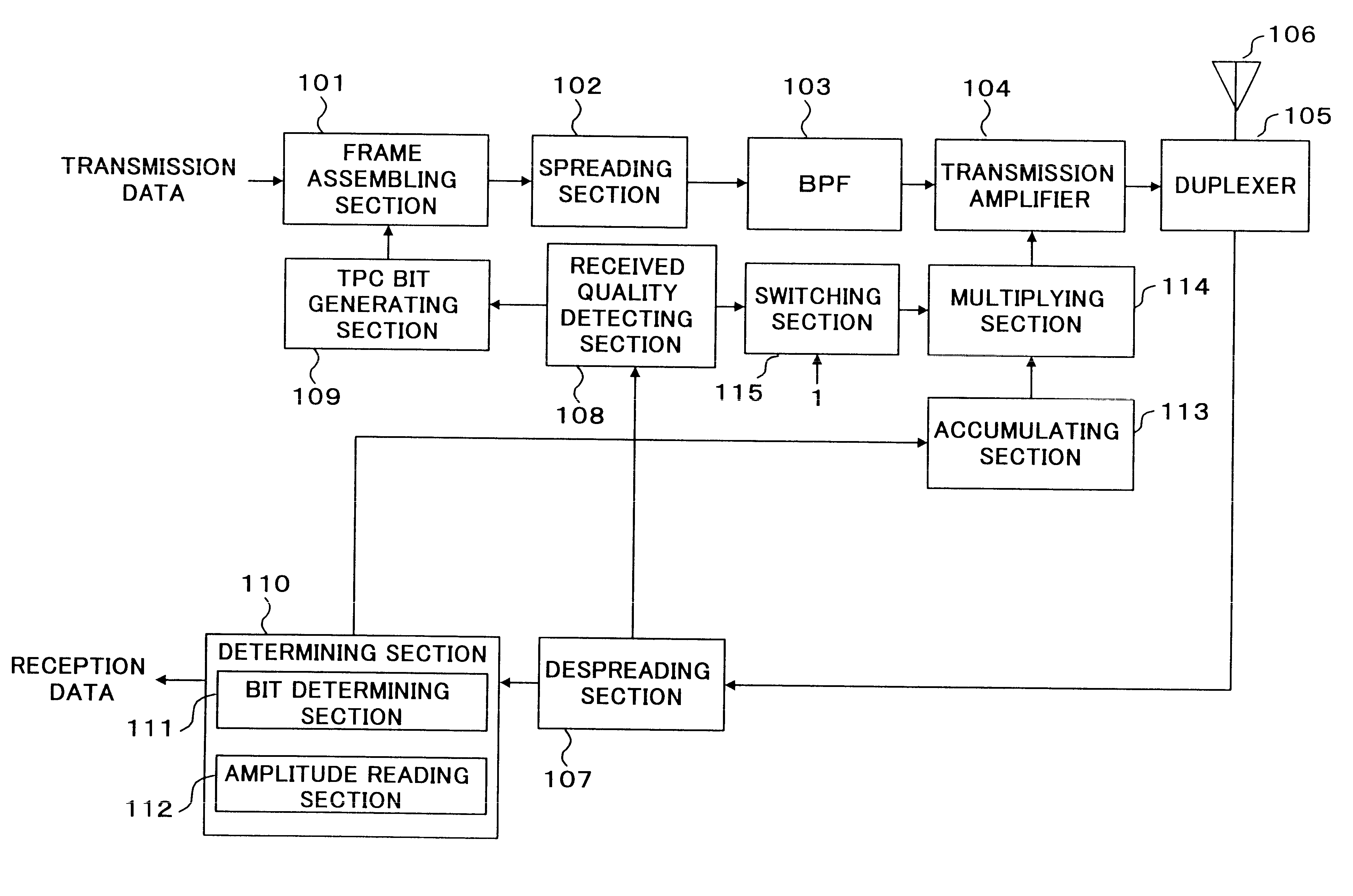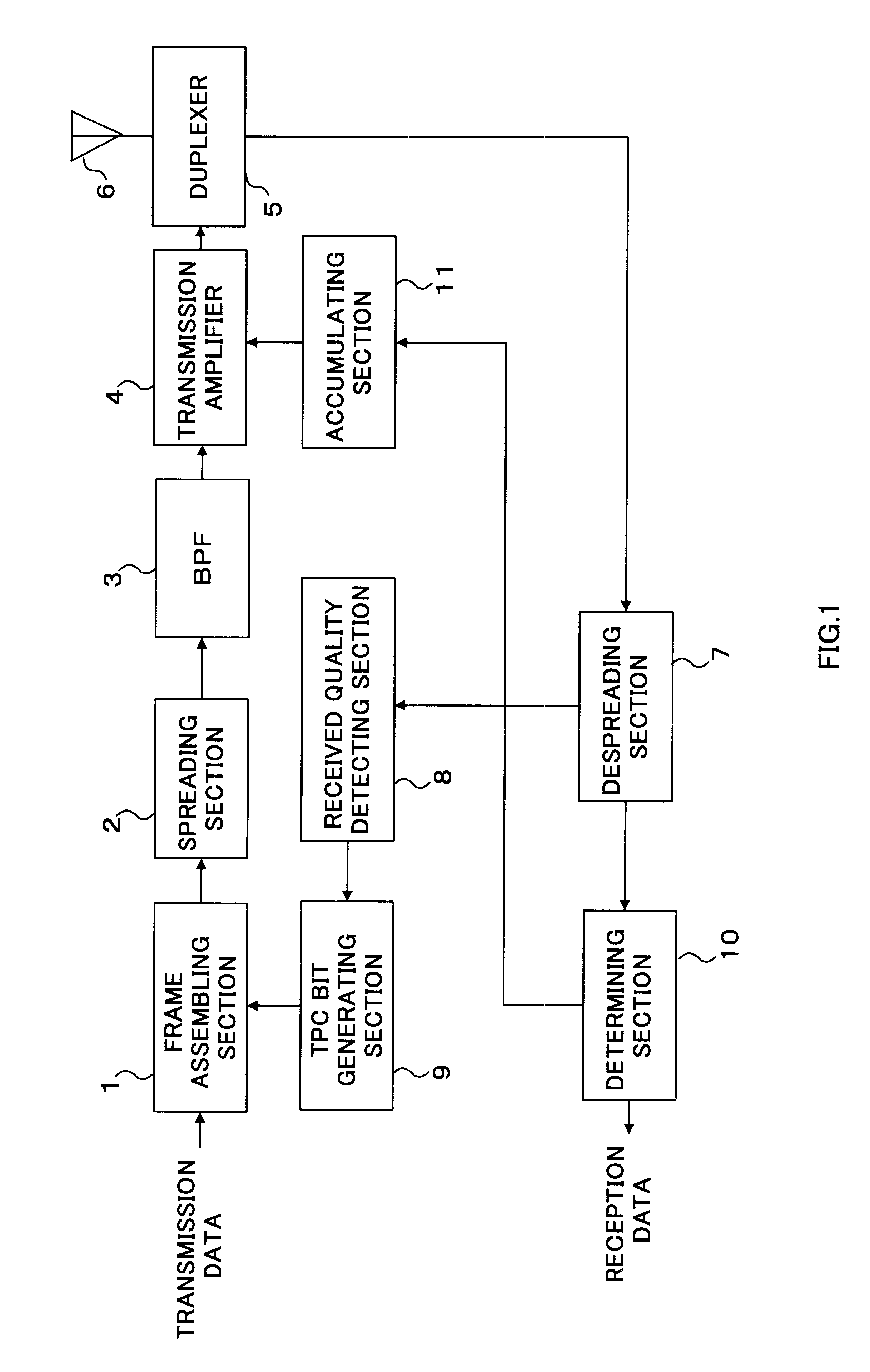Transmitter-receiver, and method for controlling transmission power of the same
a technology of transmission power and receiver, applied in power management, multiplex communication, wireless communication, etc., can solve the problems poor traceability, and appropriately controlling transmitting power, and achieve the effect of reducing data transmission efficiency
- Summary
- Abstract
- Description
- Claims
- Application Information
AI Technical Summary
Benefits of technology
Problems solved by technology
Method used
Image
Examples
embodiment 1
Then, the configuration of received quality detecting section 108 is described in detail using FIG. 3. FIG.3 is a main block diagram showing an outlined configuration of the received quality detecting section according to
For a despread signal entered in received quality detecting section 108, an SIR is measured by SIR measuring section 201 first. Subtracting section 202 subtracts a reference SIR retained by storing section 203 from the SIR of the measured reception signal (hereinafter referred to as "measured SIR") and sends the result to positive / negative determining section 204. Positive / negative determining section 204 determines whether the subtraction result is positive or negative and sends the result to TPC bit generating section 109. This allows TPC bit generating section 109 to determine 0 or 1, that is, whether to instruct to increase or decrease transmit power and generate the bit.
Dividing section 205 calculates the ratio of the measured SIR to the reference SIR and sends...
embodiment 2
The transmission / reception apparatus according to the present embodiment has the same configuration as that in Embodiment 1, provided, however, with a limiter to prevent the transmission amplifier from being requested to increase transmit power excessively.
The limiter can be placed 1) between the multiplying section and transmission amplifier, 2) between the received quality detecting section and switching section, 3) between the accumulating section and multiplying section and 4) between the determining section and accumulating section. Cases 1) to 4) will be explained below using FIG. 4 to FIG. 7. The parts with the same configuration as that in Embodiment 1 are assigned the same codes and their detailed explanations are omitted.
The configuration of the transmission / reception apparatus when a limiter is placed 1) between the multiplying section and transmission amplifier is shown in FIG. 4. In FIG. 4, an amplitude control value of transmit power sent from multiplying section 114 t...
embodiment 3
The present embodiment explains a case where in compressed mode, an increase or decrease and an amount of the increase or decrease of transmit power are indicated by the symbol and amplitude of the TPC bit. Here, the compressed mode refers to a mode in which the spreading factor for data being transmitted continuously is reduced and transmission is performed with power of the part corresponding to the changed spreading factor increased instead, thus compressing the transmission time as shown in FIG. 9 and FIG. 10. The compressed mode is sometimes also called "slotted mode."
The compressed mode allows other carriers to be monitored during a free time spared by compressing the transmission time. This allows information of different carriers to be monitored without reducing the amount of information transmitted during a communication. In this case, it is possible to monitor the communication and different carriers through a single reception section.
For example, if the spreading factor c...
PUM
 Login to View More
Login to View More Abstract
Description
Claims
Application Information
 Login to View More
Login to View More - R&D
- Intellectual Property
- Life Sciences
- Materials
- Tech Scout
- Unparalleled Data Quality
- Higher Quality Content
- 60% Fewer Hallucinations
Browse by: Latest US Patents, China's latest patents, Technical Efficacy Thesaurus, Application Domain, Technology Topic, Popular Technical Reports.
© 2025 PatSnap. All rights reserved.Legal|Privacy policy|Modern Slavery Act Transparency Statement|Sitemap|About US| Contact US: help@patsnap.com



